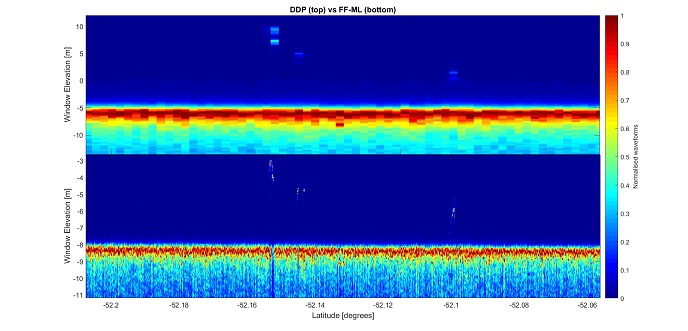Abstract's details
Fully-Focussed iceberg detection with Sentinel-6 data and prospects for CRISTAL
Event: 2022 Ocean Surface Topography Science Team Meeting
Session: Science IV: Altimetry for Cryosphere and Hydrology
Presentation type: Poster
Sentinel-6 is an operational oceanography programme consisting on two satellites that will map the sea surface levels with great precision. Sentinel-6 includes two identical satellites with the first launched on November 21, 2020 (Sentinel-6 Michael Freilich) and the second scheduled for launch in 2025 (satellite B). Following its launch, the Sentinel-6 Validation Team (S6VT) has carried out validation activities with Sentinel-6 Michael Freilich data for more than a year to ensure the best possible outcome of the mission.
Thanks to the transmission pattern of Sentinel-6 Poseidon-4 (continuous transmission at 9kHz PRF, Open Burst mode), the data can be processed using Fully-Focussed SAR techniques, which enables a much better along track resolution and also better scene focussing. This is highly beneficial over sea ice areas, where the coherence of the scene is kept during the illumination time and very detailed features, such as small leads and icebergs, can be precisely acquired.
This work will show how we can use Sentinel-6 Poseidon-4 radar altimeter data over sea ice waters to detect the presence of small icebergs and extract useful parameters from them. Furthermore, we will show the improvement obtained in resolution when analysing the data using Fully-Focussed techniques over conventional unfocussed SAR processing.
Nevertheless, carrying a single radar antenna (as it happens in the Sentinel-6 Poseidon-4 radar altimeter) severely reduces the number of parameters we can extract from the detected icebergs using this technique, as well as not allowing us to locate them with precision.
The future Copernicus Polar Ice and Snow Topography Altimeter mission (CRISTAL), with an expected launch on 2027, will carry on-board as its main payload the IRIS altimeter. Amongst other improvements with respect to previous missions, a key feature from the IRIS altimeter will be the use of 2 antennas in the Ku band allowing the determination of the across track location using the SAR interferometric (SARIn) information. The use of an interferometric mode greatly improves the information we can extract from the small icebergs detected, as well as to locate them with great precision with respect to the satellite track.
To finalise this work, we will show which are the future prospects regarding iceberg detection for CRISTAL, and how it will allow us to combine the Fully Focussed analysis techniques used during the S6VT activities with the SARIn mode to maximise the information and resolution we can obtain detecting icebergs.

Thanks to the transmission pattern of Sentinel-6 Poseidon-4 (continuous transmission at 9kHz PRF, Open Burst mode), the data can be processed using Fully-Focussed SAR techniques, which enables a much better along track resolution and also better scene focussing. This is highly beneficial over sea ice areas, where the coherence of the scene is kept during the illumination time and very detailed features, such as small leads and icebergs, can be precisely acquired.
This work will show how we can use Sentinel-6 Poseidon-4 radar altimeter data over sea ice waters to detect the presence of small icebergs and extract useful parameters from them. Furthermore, we will show the improvement obtained in resolution when analysing the data using Fully-Focussed techniques over conventional unfocussed SAR processing.
Nevertheless, carrying a single radar antenna (as it happens in the Sentinel-6 Poseidon-4 radar altimeter) severely reduces the number of parameters we can extract from the detected icebergs using this technique, as well as not allowing us to locate them with precision.
The future Copernicus Polar Ice and Snow Topography Altimeter mission (CRISTAL), with an expected launch on 2027, will carry on-board as its main payload the IRIS altimeter. Amongst other improvements with respect to previous missions, a key feature from the IRIS altimeter will be the use of 2 antennas in the Ku band allowing the determination of the across track location using the SAR interferometric (SARIn) information. The use of an interferometric mode greatly improves the information we can extract from the small icebergs detected, as well as to locate them with great precision with respect to the satellite track.
To finalise this work, we will show which are the future prospects regarding iceberg detection for CRISTAL, and how it will allow us to combine the Fully Focussed analysis techniques used during the S6VT activities with the SARIn mode to maximise the information and resolution we can obtain detecting icebergs.

Contribution: SC42022-Fully-Focussed_iceberg_detection_with_Sentinel-6_data_and_prospects_for_CRISTAL.pdf (pdf, 914 ko)
Back to the list of abstract